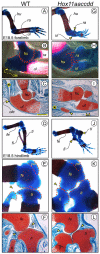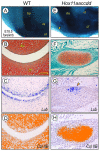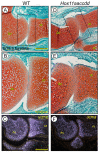Hox11 genes establish synovial joint organization and phylogenetic characteristics in developing mouse zeugopod skeletal elements
- PMID: 20978074
- PMCID: PMC3049277
- DOI: 10.1242/dev.053447
Hox11 genes establish synovial joint organization and phylogenetic characteristics in developing mouse zeugopod skeletal elements
Abstract
Hox11 genes are essential for zeugopod skeletal element development but their roles in synovial joint formation remain largely unknown. Here, we show that the elbow and knee joints of mouse embryos lacking all Hox11 paralogous genes are specifically remodeled and reorganized. The proximal ends of developing mutant ulna and radius elements became morphologically similar and formed an anatomically distinct elbow joint. The mutant ulna lacked the olecranon that normally attaches to the triceps brachii muscle tendon and connects the humerus to the ulna. In its place, an ulnar patella-like element developed that expressed lubricin on its ventral side facing the joint and was connected to the triceps muscle tendon. In mutant knees, both tibia and fibula fully articulated with an enlarged femoral epiphyseal end that accommodated both elements, and the neo-tripartite knee joint was enclosed in a single synovial cavity and displayed an additional anterior ligament. The mutant joints also exhibited a different organization of the superficial zone of articular cartilage that normally exerts an anti-friction function. In conclusion, Hox11 genes co-regulate and coordinate the development of zeugopod skeletal elements and adjacent elbow and knee joints, and dictate joint identity, morphogenesis and anatomical and functional organization. Notably, the ulnar patella and tripartite knee joints in the mouse mutants actually characterize several lower vertebrates, including certain reptiles and amphibians. The re-emergence of such anatomical structures suggests that their genetic blueprint is still present in the mouse genome but is normally modified to the needs of the mammalian joint-formation program by distinct Hox11 function.
Figures





Similar articles
-
Hox11 expression characterizes developing zeugopod synovial joints and is coupled to postnatal articular cartilage morphogenesis into functional zones in mice.Dev Biol. 2021 Sep;477:49-63. doi: 10.1016/j.ydbio.2021.05.007. Epub 2021 May 16. Dev Biol. 2021. PMID: 34010606 Free PMC article.
-
Hox11 paralogous genes are required for formation of wrist and ankle joints and articular surface organization.Ann N Y Acad Sci. 2010 Mar;1192:307-16. doi: 10.1111/j.1749-6632.2009.05234.x. Ann N Y Acad Sci. 2010. PMID: 20392252
-
Hox11 genes are required for regional patterning and integration of muscle, tendon and bone.Development. 2013 Nov;140(22):4574-82. doi: 10.1242/dev.096693. Epub 2013 Oct 23. Development. 2013. PMID: 24154528 Free PMC article.
-
Mechanisms of synovial joint and articular cartilage formation: recent advances, but many lingering mysteries.Birth Defects Res C Embryo Today. 2005 Sep;75(3):237-48. doi: 10.1002/bdrc.20050. Birth Defects Res C Embryo Today. 2005. PMID: 16187328 Review.
-
The development of synovial joints.Curr Top Dev Biol. 2007;79:1-36. doi: 10.1016/S0070-2153(06)79001-9. Curr Top Dev Biol. 2007. PMID: 17498545 Review.
Cited by
-
The skeletal site-specific role of connective tissue growth factor in prenatal osteogenesis.Dev Dyn. 2012 Dec;241(12):1944-59. doi: 10.1002/dvdy.23888. Epub 2012 Nov 5. Dev Dyn. 2012. PMID: 23073844 Free PMC article.
-
Joints in the appendicular skeleton: Developmental mechanisms and evolutionary influences.Curr Top Dev Biol. 2019;133:119-151. doi: 10.1016/bs.ctdb.2018.11.002. Epub 2018 Dec 10. Curr Top Dev Biol. 2019. PMID: 30902250 Free PMC article. Review.
-
Hox11 expression characterizes developing zeugopod synovial joints and is coupled to postnatal articular cartilage morphogenesis into functional zones in mice.Dev Biol. 2021 Sep;477:49-63. doi: 10.1016/j.ydbio.2021.05.007. Epub 2021 May 16. Dev Biol. 2021. PMID: 34010606 Free PMC article.
-
Pilot report: non-operative treatment of Mayo Type II olecranon fractures in any-age adult patient.Shoulder Elbow. 2017 Oct;9(4):285-291. doi: 10.1177/1758573217711889. Epub 2017 Jun 5. Shoulder Elbow. 2017. PMID: 28932286 Free PMC article.
-
Transcriptome dynamics of long noncoding RNAs and transcription factors demarcate human neonatal, adult, and human mesenchymal stem cell-derived engineered cartilage.J Tissue Eng Regen Med. 2020 Jan;14(1):29-44. doi: 10.1002/term.2961. Epub 2019 Dec 18. J Tissue Eng Regen Med. 2020. PMID: 31503387 Free PMC article.
References
-
- Archer C. W., Dowthwaite G. P., Francis-West P. (2003). Development of synovial joints. Birth Defects Research, Pt. C 69, 144-155 - PubMed
-
- Boulet A. M., Capecchi M. R. (2003). Multiple roles of Hoxa11 and Hoxd11 in the formation of the mammalian forelimb zeugopod. Development 131, 299-309 - PubMed
-
- Carroll S. B. (2008). Evo-Devo and an expanding evolutionary synthesis; a genetic theory of morphological evolution. Cell 134, 25-36 - PubMed
Publication types
MeSH terms
Substances
Grants and funding
LinkOut - more resources
Full Text Sources
Other Literature Sources
Molecular Biology Databases

